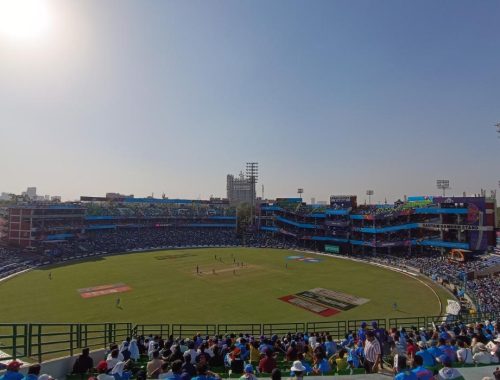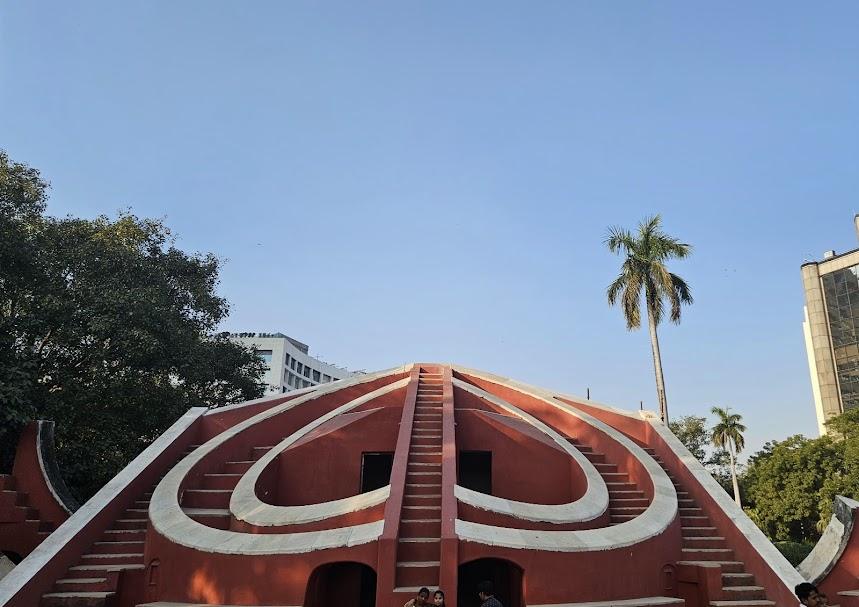
Jantar Mantar, Delhi: Everything You Should Know About
Jantar Mantar in Delhi is a famous historical site that highlights India’s rich knowledge of astronomy. It was built in 1724 by Maharaja Jai Singh II, this observatory has large instruments designed to study the movement of celestial bodies. The name “Jantar Mantar” comes from the Sanskrit words “Yantra” (instrument) and “Mantra” (formula), meaning “instruments for measuring the sky.” Located near Connaught Place, it is one of five observatories built by the king, with others in Jaipur, Ujjain, Mathura, and Varanasi.
In this guide, we will cover Jantar Mantar’s history, unique architecture, ticket prices, timings, and visitor tips to help you plan your visit. Keep reading!
Jantar Mantar, Delhi: History, Architecture, and Scientific Significance
Maharaja Jai Singh II, a keen astronomer and the founder of Jaipur, constructed Jantar Mantar in 1724. His primary aim was to refine existing astronomical data and improve the accuracy of celestial observations. During this period, the observatory played a crucial role in predicting the movements of celestial bodies, essential for various aspects of daily life, including agriculture and navigation. Jantar Mantar is a UNESCO World Heritage Site and an important example of India’s scientific advancements in the 18th century. It continues to attract history lovers, astronomy enthusiasts, and photographers who admire its unique architecture and purpose.
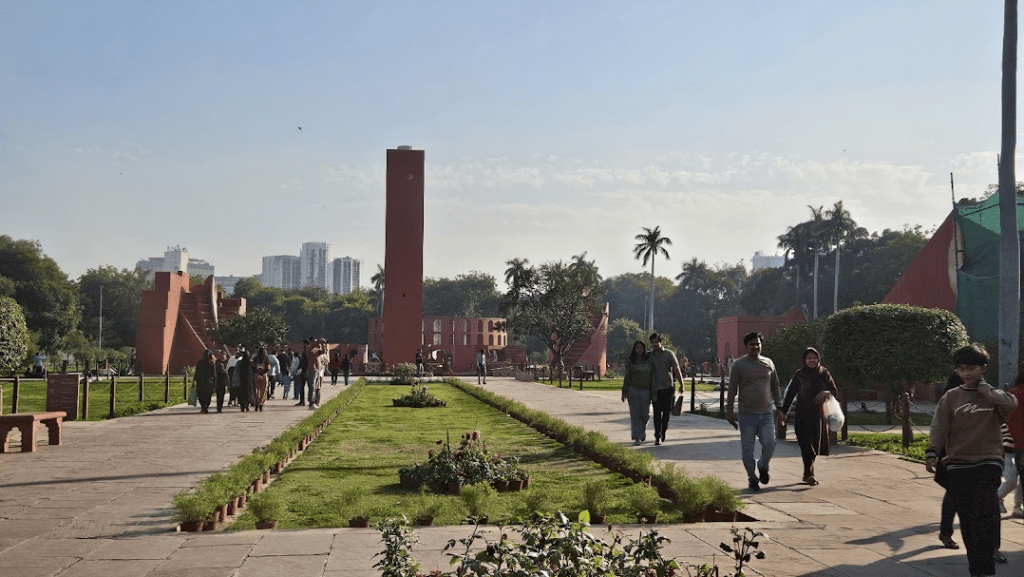
Jantar Mantar, Delhi: Architectural Wonders
Jantar Mantar comprises several impressive instruments, each serving a specific purpose:
- Samrat Yantra: This massive triangular structure functions as an equal-hour sundial. Standing at 70 feet tall, it accurately measures time and the declination of celestial bodies.
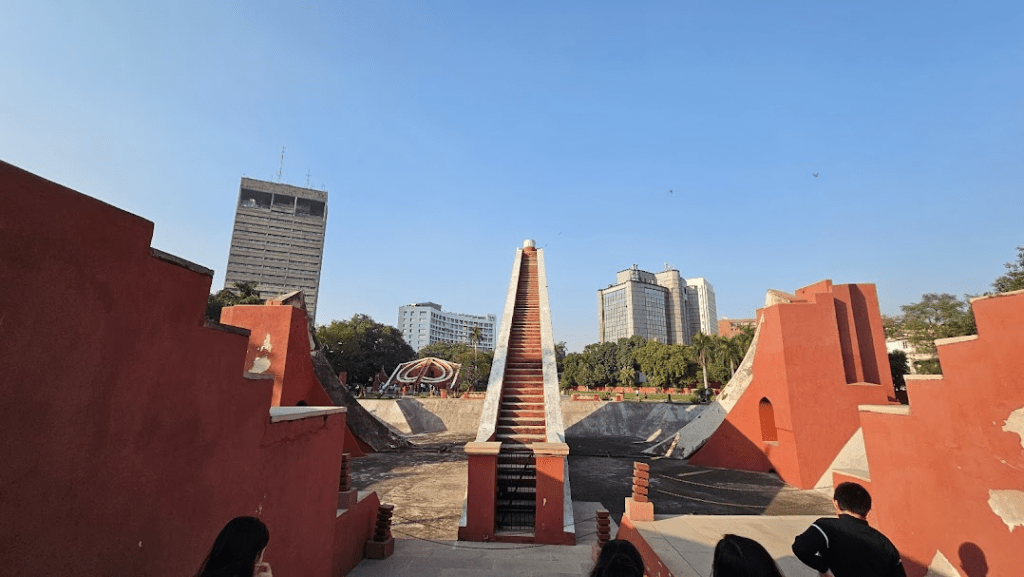
- Rama Yantra: Consisting of two large cylindrical structures with open tops, the Rama Yantra is used to measure the altitude of stars on the basis of latitude and longitude on Earth.
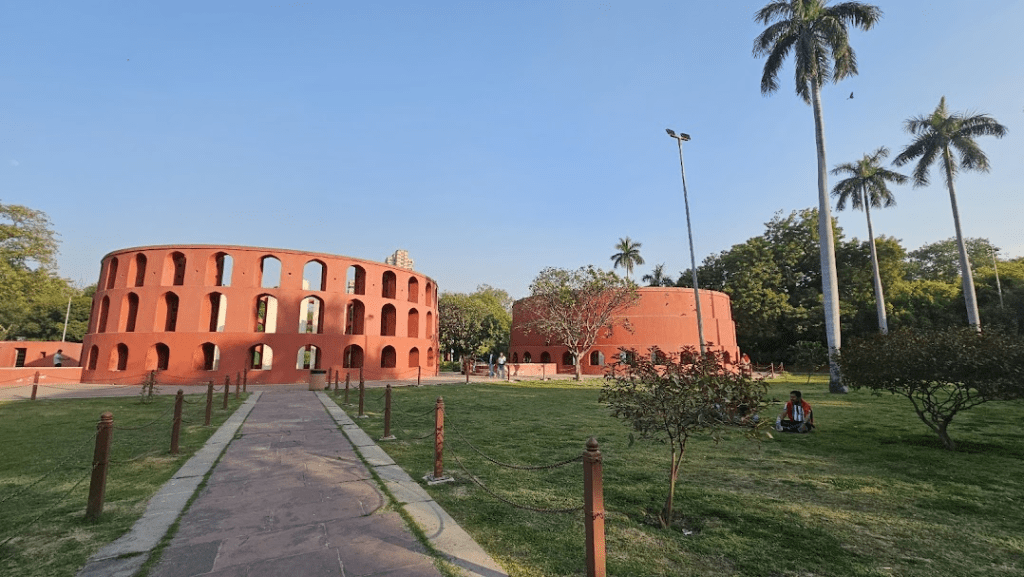
- Jai Prakash Yantra: This instrument features hollowed-out hemispheres with markings on their concave surfaces. Observers inside can align the position of a star with various markings to determine celestial coordinates.

Image source: Indiamart.com
- Misra Yantra: A unique composition of five instruments, the Misra Yantra is designed to determine the shortest and longest days of the year and indicate the exact moment of noon in many cities worldwide.
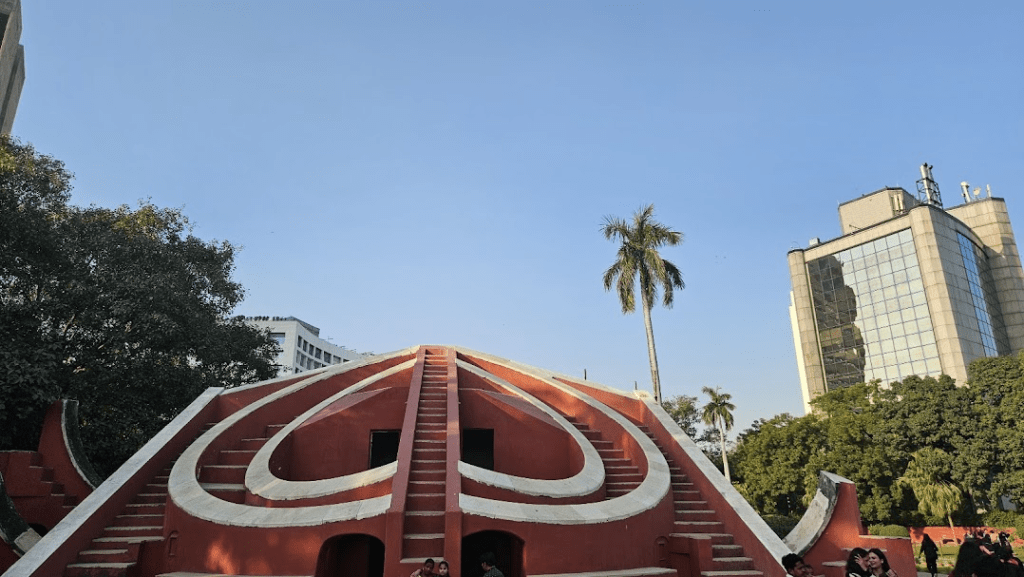
The Scientific Significance of Jantar Mantar’s Yantras (Instruments)
Each instrument at Jantar Mantar was carefully designed for precise astronomical calculations:
- Samrat Yantra – Measures local time and celestial declination with high accuracy.
- Rama Yantra – Determines the altitude of celestial objects.
- Jai Prakash Yantra – Measures the movement of the sun and stars.
- Misra Yantra – Identifies the shortest and longest days of the year.
These instruments reflect India’s advanced understanding of astronomy in the 18th century.
Also Read: Red Fort: A Comprehensive Guide to Delhi’s Iconic Monument
Visitor’s Guide to Jantar Mantar Delhi: Location, Timings, and Entry Fees
- Location: Jantar Mantar is situated near Connaught Place in New Delhi, making it easily accessible from various parts of the city.
- Nearest Metro Station: The closest metro station to Jantar Mantar is Patel Chowk, located on the Yellow Line of the Delhi Metro. You can also come via Rajiv Chowk and Janpath Metro Station.
- Timings: The observatory is open daily from 6:00 AM to 6:00 PM.
Jantar Mantar Entry Fee:
- ₹25 for Indian nationals.
- ₹250 for foreign visitors.
Facilities:
- Restrooms are available on-site.
- Food and drinks are not permitted inside the premises, but vendors are present outside.
Guided Tours: Audio guides are available, providing detailed explanations of each instrument and the history of the observatory. These guides are offered in multiple languages, allowing visitors to explore at their own pace.
My Personal Experience Visiting Jantar Mantar in Delhi
During my visit to Jantar Mantar in Delhi, I went in the late afternoon of February. The crowd was moderate—enough to make the place feel lively, but not overwhelming. If you are planning your trip, you’ll find India Gate just a short distance away, and Janpath Market is also close for some quick shopping. For a relaxed hangout, Connaught Place is a great spot, and it’s only a few minutes from Jantar Mantar.
However, if you are someone who would love photography at Jantar Mantar, I’d recommend visiting in the morning on a weekday. When I went on a weekend afternoon, the place was relatively busy, which made it a little challenging to capture clear shots without people in the frame. The lighting is also softer in the morning, which can help improve your photos of the astronomical instruments and yantras at Jantar Mantar.
So, if you are looking for a quieter experience and better photos, aim for an early visit on a weekday. It’ll give you a chance to explore the historic site without the crowds and capture the perfect shot of its fascinating instruments.
Tips for Visiting Jantar Mantar Delhi
- Best Time to Visit: To avoid crowds and the midday heat, it’s advisable to visit early in the morning or late in the afternoon.
- Nearby Attractions: Try combining your visit with nearby sites such as Agrasen Ki Baoli and India Gate for a more comprehensive experience.
- Respect the Site: Please refrain from climbing or defacing the historical structures to help preserve their integrity for future generations.
Fascinating Facts About Jantar Mantar, Delhi
- Multiple Observatories: Delhi’s Jantar Mantar is one of five built by Maharaja Jai Singh II.
- Architectural Brilliance: It combines science and architecture, showcasing India’s astronomical expertise.
- Unique Instruments: Jantar Mantar houses 13 unique astronomical instruments, each designed for specific observations, such as measuring time, tracking celestial objects, and predicting eclipses.
- Construction Materials: The observatory’s structures are built using brick, limestone, and rubble, materials chosen for their durability to ensure the instruments’ longevity.
- Historical Decay and Restoration: By 1867, during British rule, Jantar Mantar had decayed significantly. Efforts have since been made to preserve and restore this historical site.
- Architectural Significance: The observatory is a blend of architectural innovation and scientific prowess, reflecting the advanced understanding of astronomy in 18th-century India.
- Cultural Symbol: The design of Jantar Mantar was used as the logo for the 1982 Asian Games, highlighting its significance in India’s cultural and scientific heritage.
Takeaway
Jantar Mantar is a must-visit for history lovers, science enthusiasts, and travelers. It offers a glimpse into India’s past scientific achievements and stunning architecture. If you are in Delhi, don’t miss this chance to explore a site where history and astronomy come together! By following this guide, you’ll have all the information needed for an enriching visit to Jantar Mantar Delhi.
Frequently Asked Questions (FAQs)
1. What is Jantar Mantar in Delhi?
Jantar Mantar is an ancient astronomical observatory situated in New Delhi, built in 1724 by Maharaja Jai Singh II. It entails several architectural instruments designed for celestial observations, reflecting India’s rich scientific heritage.
2. Where is Jantar Mantar situated in Delhi?
Jantar Mantar is located near Connaught Place in the core of New Delhi, making it easily accessible from various parts of the city.
3. What are the visiting hours of Jantar Mantar?
Jantar Mantar is open daily from 6:00 AM to 6:00 PM. It’s advisable to check the current timings before your visit, as they can change.
4. What is the entry fee for Jantar Mantar?
The entry fee is ₹25 for Indian nationals and ₹300 for foreign visitors. Children below 15 years of age can enter free of charge.
5. How can I reach Jantar Mantar using public transportation?
The nearest metro station to Jantar Mantar are Patel Chowk, Rajiv Chowk, and Janpath Metro. From there, it’s a short walk to the observatory.
6. Are guided tours available at Jantar Mantar?
Yes, audio guides are available on-site, providing detailed explanations of each instrument and the history of the observatory. These guides are offered in multiple languages, allowing visitors to explore at their own pace.
7. How much time should I allocate for a visit to Jantar Mantar?
Visitors usually spend about 30 minutes to 1 hour exploring the site, depending on their interest in astronomy and history.
8. What is the best time of year to visit Jantar Mantar?
The ideal time to visit is during the cooler months, from November to March when the weather in Delhi is more pleasant.
9. Is photography allowed inside Jantar Mantar?
Yes, photography is permitted. However, a fee of ₹25 is charged for video filming.
10. Are there any facilities available at Jantar Mantar?
Restroom facilities are available on-site. While food and drinks are not permitted inside the premises, vendors are present outside.
11. What is the Samrat Yantra used for?
The Samrat Yantra is a large sundial used to measure time and celestial positions. It helps in determining the declination of celestial bodies with high precision.
12. How does the Rama Yantra work?
The Rama Yantra consists of two large cylindrical structures designed to measure the altitude of stars. It helps astronomers study celestial movements based on the Earth’s latitude and longitude.
13. What is the purpose of the Jai Prakash Yantra?
The Jai Prakash Yantra features hemispherical structures that allow astronomers to measure the position of stars and their coordinates, aiding in celestial navigation.
14. How does the Misra Yantra determine the longest and shortest days?
The Misra Yantra is a combination of five instruments that calculate the shortest and longest days of the year and provide accurate readings for noon in various cities.
You can read more about the yantras at https://www.jantarmantar.org/
Khushi Jha
I am Khushi Jha, a proud alumna of Delhi University with a degree in History and Political Science. My fascination with the events that have shaped our world drives me every day. Currently, I am pursuing my Master’s in History, diving even deeper into global dynamics and the incredible heritage of India. I firmly believe that India's rich heritage deserves wider recognition. I strive to bring its stories to the forefront, ensuring they are celebrated and acknowledged on a global stage. I have written extensively across various niches, including fashion, health, lifestyle, real estate, hospitality, amongst others. In my free time, you’ll find me immersed in books, both fiction and non-fiction, or simply enjoying some much-needed rest.
You May Also Like
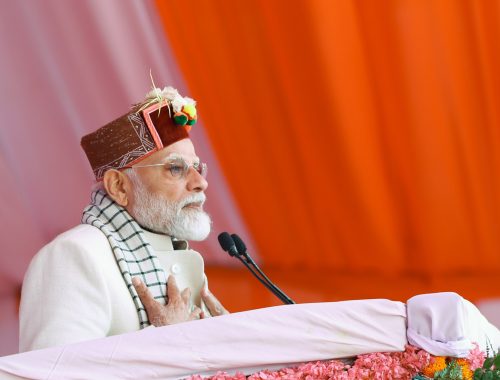
PM Modi’s Mission to Revive Villages Abandoned During 1962 India-China War
March 8, 2025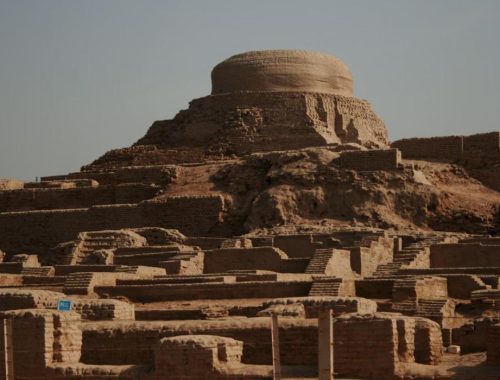
Exploring Indus Valley Civilization: History, Discoveries, and Scholarly Debates
July 27, 2024